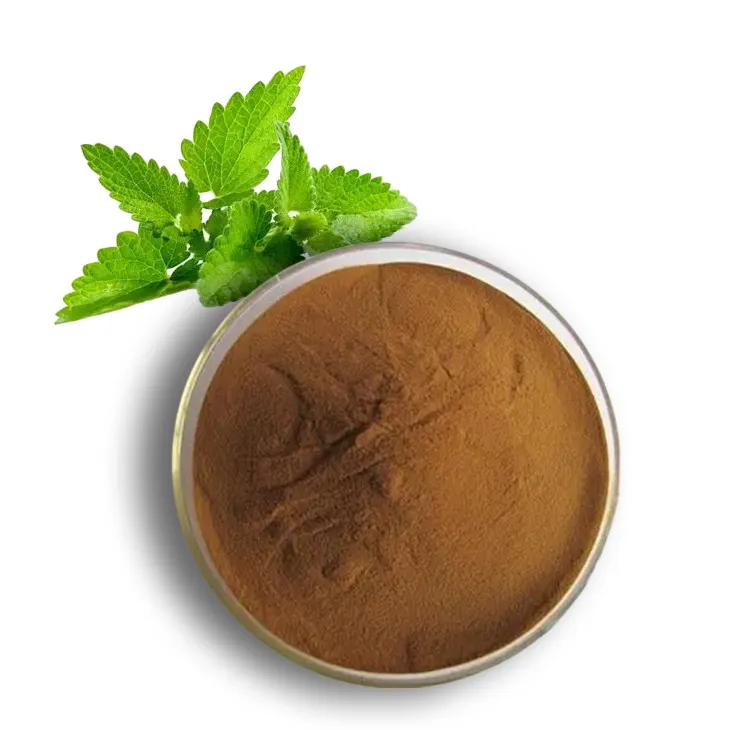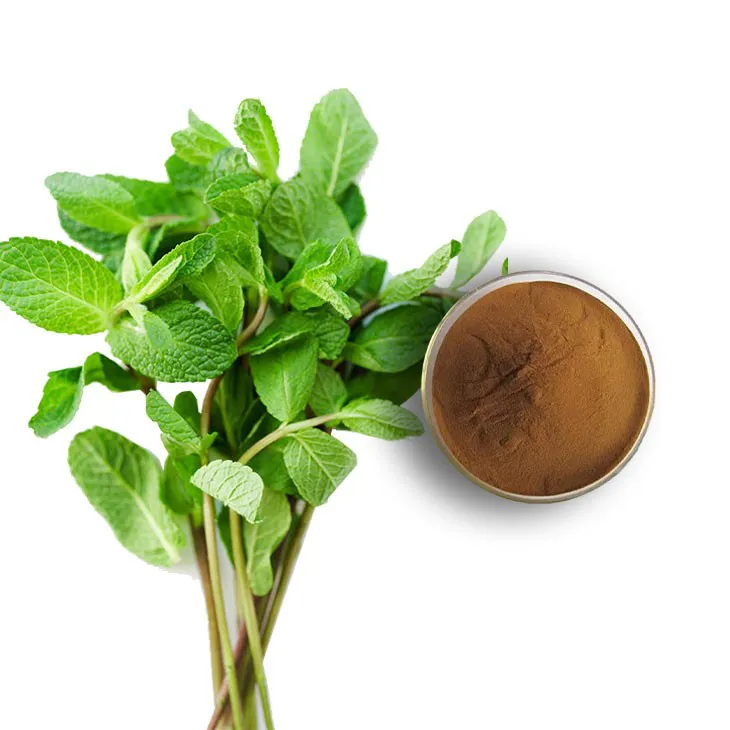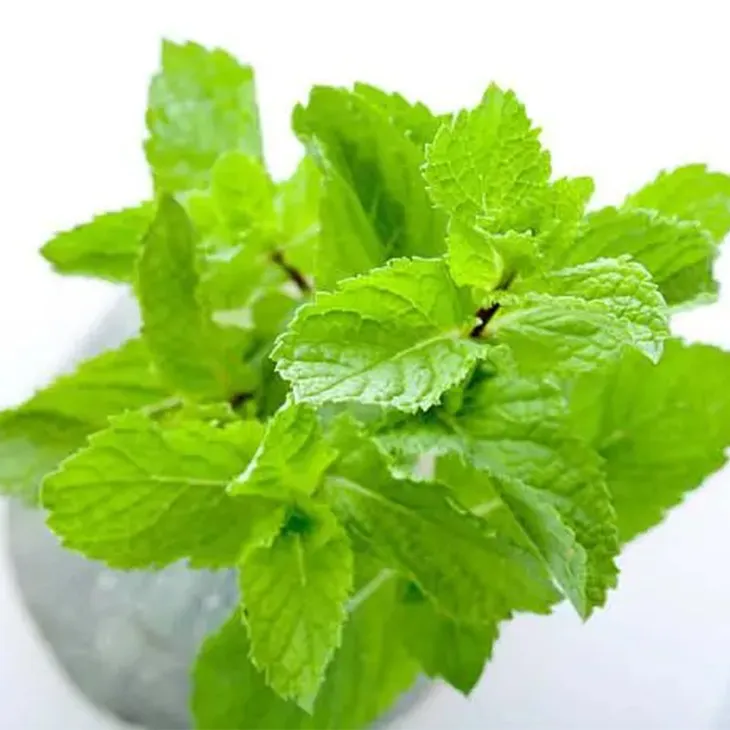- 0086-571-85302990
- sales@greenskybio.com
The process of extracting menthol from peppermint extract powder.
2024-11-29

Introduction
Peppermint, a well - known plant, is rich in various chemical components, and Peppermint Extract Powder is a concentrated form that contains these components. Menthol is one of the most important and valuable components in Peppermint Extract Powder. The extraction of menthol from this powder is not only of great significance in the field of natural product research but also has important applications in industries such as food, pharmaceuticals, and cosmetics. This article will comprehensively introduce the process of extracting menthol from Peppermint Extract Powder.

Solvent Extraction
Choice of Solvent
The first step in the extraction process is solvent extraction. Ethanol is a commonly used solvent for this purpose. Ethanol has several advantages. It is relatively safe, has a good solubility for many of the components in peppermint extract powder, and is also easily removable in later purification steps. However, other solvents such as hexane or ethyl acetate can also be considered depending on specific requirements. For example, if a more non - polar solvent is needed to target certain components along with menthol, hexane might be a choice. But ethanol remains a popular option due to its overall favorable properties.
Extraction Procedure
The peppermint extract powder is mixed thoroughly with the selected solvent. This is usually done in a suitable container, such as a glass flask or a stainless - steel vessel. The ratio of powder to solvent is crucial and needs to be optimized. A typical ratio could be, for example, 1:5 (powder to solvent by weight), but this can vary depending on the quality and composition of the peppermint extract powder. The mixture is then stirred continuously for a certain period. This can range from a few hours to overnight. Stirring helps to ensure that the solvent can fully interact with all parts of the powder and dissolve the menthol and other soluble components effectively.

Separation of Impurities
Filtration
After the solvent extraction, the next step is to remove solid impurities. Filtration is the method used for this purpose. There are different types of filtration methods that can be employed. One common method is gravity filtration. In this method, a filter paper is placed in a funnel, and the mixture is poured through it. The solid residues are retained on the filter paper, while the liquid filtrate, which contains menthol and other dissolved components, passes through. Another option is vacuum filtration, which is faster and more efficient. In vacuum filtration, a Büchner funnel is used along with a vacuum pump. The vacuum helps to draw the liquid through the filter paper more quickly, leaving the solid impurities behind.
Distillation
Once the solid impurities are removed by filtration, the next step is distillation to separate different volatile components. Distillation is based on the principle that different substances have different boiling points. The filtrate obtained from filtration is placed in a distillation apparatus. The apparatus typically consists of a flask, a condenser, and a receiving flask. When the filtrate is heated, the components with lower boiling points start to vaporize first. As the vapors rise, they pass through the condenser, where they are cooled and condensed back into liquid form. This way, different components can be separated based on their boiling points. Menthol has a relatively distinct boiling point, which allows it to be separated from other components during distillation. For example, if the boiling point of menthol is around 216 °C (at normal pressure), by carefully controlling the temperature during distillation, menthol can be collected separately.

Chromatography for Purification
Types of Chromatography
Although solvent extraction and distillation can separate menthol to a certain extent, for a more refined purification, chromatography techniques are often employed. There are several types of chromatography that can be used for menthol purification. One common type is gas chromatography (GC). In GC, the sample is vaporized and carried by an inert gas (such as helium) through a column. The column is coated with a stationary phase. Different components in the sample interact differently with the stationary phase, and based on these interactions, they are separated as they travel through the column. Another type is liquid chromatography (LC), which can be further divided into high - performance liquid chromatography (HPLC) and normal - phase liquid chromatography. In HPLC, a liquid mobile phase is used to carry the sample through a column filled with a stationary phase. The high pressure used in HPLC allows for faster and more efficient separation.
Chromatography Procedure
For menthol purification using chromatography, the sample obtained after distillation is prepared in a suitable solvent and injected into the chromatography system. In the case of GC, the injector is set at an appropriate temperature to ensure complete vaporization of the sample. The oven temperature of the GC is then programmed to gradually increase or maintain a certain temperature profile to optimize the separation of menthol from other components. In LC, the mobile phase is pumped at a specific flow rate through the column. The detector at the end of the column detects the separated components, and the data is recorded. By carefully analyzing the chromatogram, the pure menthol fraction can be identified and collected for further use.
Quality Control and Analysis
Analytical Methods
After the extraction and purification of menthol, it is essential to conduct quality control and analysis. There are several analytical methods available for this purpose. One important method is gas chromatography - mass spectrometry (GC - MS). GC - MS combines the separation ability of gas chromatography with the identification ability of mass spectrometry. The menthol sample is first separated by GC, and then the individual components are ionized and analyzed by mass spectrometry. The mass spectrum obtained can be used to identify menthol accurately and also to detect any impurities or contaminants present. Another method is infrared spectroscopy (IR). IR spectroscopy measures the absorption of infrared light by the sample. Menthol has a characteristic IR spectrum, and by comparing the measured spectrum with the standard spectrum, the purity and identity of menthol can be determined.
Quality Standards
There are certain quality standards that menthol must meet, especially if it is intended for use in the food, pharmaceutical, or cosmetic industries. For example, in the food industry, the purity of menthol should be high enough to ensure safety and proper flavor. In the pharmaceutical industry, strict regulations govern the quality of menthol used in medications. The amount of impurities, such as heavy metals or other harmful substances, must be within very low limits. These quality standards are set by regulatory agencies such as the Food and Drug Administration (FDA) in the United States and similar agencies in other countries.
Conclusion
The process of extracting menthol from peppermint extract powder involves multiple steps, starting from solvent extraction, followed by impurity separation through filtration and distillation, and further purification using chromatography. Quality control and analysis are also crucial steps to ensure that the extracted menthol meets the required standards. Each step in the process is carefully designed and optimized to obtain high - quality menthol. With the increasing demand for natural products in various industries, the extraction of menthol from peppermint extract powder will continue to be an important area of research and development.
FAQ:
What is the first step in extracting menthol from peppermint extract powder?
The first step is often a solvent extraction process. A suitable solvent, like ethanol, is used to mix with the peppermint extract powder. This helps to dissolve the components including menthol.
Why is ethanol a suitable solvent for this extraction?
Ethanol is a suitable solvent because it can effectively dissolve the components present in the peppermint extract powder, including menthol. It has the right chemical properties to interact with the various substances in the powder and help in the extraction process.
How does filtration contribute to the extraction of menthol?
Filtration helps in the extraction of menthol by getting rid of solid residues. After the solvent extraction, there may be some solid particles remaining, and filtration is a method to separate these unwanted solids from the solution containing menthol and other dissolved components.
What role does distillation play in the menthol extraction process?
Distillation plays a crucial role in the menthol extraction process. It helps in separating different volatile components based on their boiling points. Since menthol has a relatively distinct boiling point, it can be further purified during the distillation process as the components with different boiling points are separated.
Why is chromatography sometimes used in the menthol extraction?
Chromatography is sometimes used in the menthol extraction for a more refined separation and purification. It can separate and purify menthol to a high - quality level by exploiting the differences in the chemical properties of the components in the mixture, ensuring a more precise extraction.
Related literature
- Menthol: Production, Chemistry, and Applications"
- "Extraction and Purification of Menthol from Natural Sources: A Review"
- "Advanced Techniques in Menthol Isolation from Peppermint Extracts"
- ▶ Hesperidin
- ▶ citrus bioflavonoids
- ▶ plant extract
- ▶ lycopene
- ▶ Diosmin
- ▶ Grape seed extract
- ▶ Sea buckthorn Juice Powder
- ▶ Beetroot powder
- ▶ Hops Extract
- ▶ Artichoke Extract
- ▶ Reishi mushroom extract
- ▶ Astaxanthin
- ▶ Green Tea Extract
- ▶ Curcumin Extract
- ▶ Horse Chestnut Extract
- ▶ Other Problems
- ▶ Boswellia Serrata Extract
- ▶ Resveratrol Extract
- ▶ Marigold Extract
- ▶ Grape Leaf Extract
- ▶ blog3
- ▶ blog4
-
Chinese peppermint oil powder factories.
2024-11-29
-
The best green tea extract on the market.
2024-11-29
-
Nature's Bounty Okra Extract.
2024-11-29
-
Chinese Oyster Peptide Powder Factories.
2024-11-29
-
The best organic L - carnitine.
2024-11-29
-
Certified organic acerola cherry extract.
2024-11-29
-
Coconut Water Powder
2024-11-29
-
Chasteberry Extract
2024-11-29
-
Quercetin
2024-11-29
-
Aminolevulinic acid
2024-11-29
-
melatonin extract
2024-11-29
-
Lotus leaf extract
2024-11-29
-
Black Rice Extract
2024-11-29
-
Alisma Extract
2024-11-29
-
Sea buckthorn Juice Powder
2024-11-29
-
Gynostemma pentaphyllum extract
2024-11-29





















